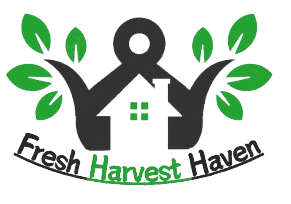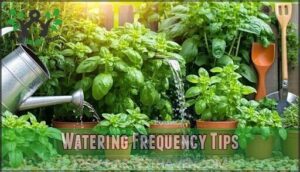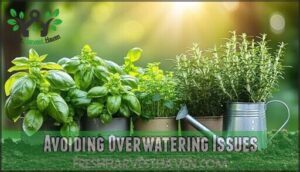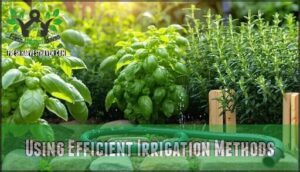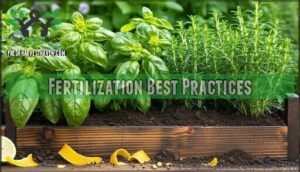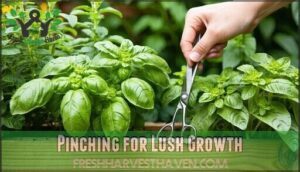This site is supported by our readers. We may earn a commission, at no cost to you, if you purchase through links.
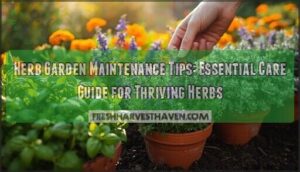
Most herbs prefer well-draining soil, so avoid soggy conditions that lead to root rot. Feed plants monthly with balanced fertilizer during growing season.
Pinch flowers regularly to keep leaves tender and flavorful. Harvest frequently by cutting stems just above leaf pairs to encourage bushy growth.
Watch for common pests like aphids and spider mites, using companion planting with marigolds for natural protection. The real game-changer lies in understanding each herb’s unique seasonal needs and timing, which involves consistent watering and natural protection to ensure a healthy herb garden.
Table Of Contents
- Key Takeaways
- Herb Garden Establishment
- Watering Herb Gardens
- Feeding and Pruning Herbs
- Pest and Disease Control
- Harvesting and Maintaining
- Frequently Asked Questions (FAQs)
- How do you maintain a herb garden?
- What herbs should not go next to each other?
- What is the mother of all herbs?
- Do I need to cut back my herbs?
- How do I care for my herb garden?
- How do I become a successful herb gardener?
- Can you use fresh manure in a herb garden?
- How do I Keep my herb garden weed-free?
- How often should I water my herb garden?
- How do you keep herbs from rotting?
- Conclusion
Key Takeaways
- Check soil moisture daily by inserting your finger 1-2 inches deep—water when it feels dry, but avoid overwatering since soggy conditions cause root rot
- Pinch flowers and stem tips regularly to keep leaves tender and encourage bushy growth, harvesting up to one-third of the plant at a time
- Use natural pest control methods like companion planting with marigolds and releasing beneficial insects rather than harsh chemicals
- Feed your herbs monthly with balanced fertilizer during growing season, but remember most herbs prefer light feeding over heavy fertilization
Herb Garden Establishment
Starting a successful herb garden begins with proper planning and preparation that sets your plants up for long-term success.
You’ll want to focus on three key areas: preparing nutrient-rich, well-draining soil, selecting the ideal location with appropriate sunlight exposure, and choosing herb varieties that match both your cooking needs and local growing conditions.
Soil Preparation Tips
When establishing your herb garden soil, proper preparation sets the foundation for healthy plants. Start with Soil Testing to determine your Soil pH – most herbs thrive between 6.0-7.0. Next, assess your Soil Type and Soil Drainage to identify improvement needs.
Here’s your soil preparation roadmap:
- Test soil conditions annually for ideal pH levels
- Mix Organic Matter like compost into existing Herb Garden Soil
- Add Soil Amendments gradually, working into top 6-8 inches
- Focus on Drainage Improvement to prevent root rot
Compost Amendment enriches soil naturally while improving structure. Work amendments thoroughly to create ideal growing conditions for your herbs. Consider using a reliable pH meter for accurate readings.
Choosing Right Herb Location
Where should you position your herb garden for maximal growth? Location determines your herbs’ success or failure.
Consider these essential factors when selecting your spot:
- Sunlight Exposure – Choose areas receiving 6+ hours of direct sunlight daily, as most herbs require full sun for robust flavor development
- Soil Drainage – Guarantee well-draining soil conditions to prevent waterlogging and root rot in your herb garden sunlight zones
- Accessibility Needs – Position gardens within easy reach for daily harvesting and maintenance tasks
Evaluate microclimates around your property, avoiding areas with harsh winds or extreme temperature fluctuations that could stress plants.
Selecting Herb Varieties
When choosing herb varieties for your garden, prioritize beginner herbs like basil, chives, and parsley that match your culinary preferences and local climate and soil conditions.
Consider each herb’s sunlight needs and mature sizes when planning your layout. Test your soil pH annually, as most herbs thrive between 6.0-7.0.
Select hardy herbs with complementary flavors, such as dill, parsley, and cilantro. Practice companion planting by pairing basil with tomatoes for natural pest control.
Container-grow aggressive spreaders like mint and lemon balm to prevent garden takeover. Remember that good drainage is essential to prevent waterlogging.
Smart herb selection guarantees thriving plants.
Watering Herb Gardens
Proper watering keeps your herbs healthy and flavorful, but finding the right balance takes practice.
Too much water kills more herbs than drought, so you’ll need to master when and how much to water for the best results.
Watering Frequency Tips
Your watering frequency depends on several factors that you’ll master with practice. Check soil moisture levels by inserting your finger two inches deep—dry soil means it’s time to water. Container watering requires more attention since pots dry faster than ground plantings. Herb variety matters too; mint needs daily moisture while oregano prefers less frequent drinks.
Make seasonal adjustments as temperatures change. Summer heat increases water needs, while cooler months require less. Climate impact affects your schedule—humid areas need less frequent watering than dry regions. Consistent timing helps establish strong root systems.
- Test soil moisture before each watering session
- Water container herbs more frequently than ground plants
- Adjust schedules based on seasonal temperature changes
- Consider your local climate when planning watering routines
- Monitor individual herb needs for ideal plant health
Avoiding Overwatering Issues
Between root systems and success lies proper watering depth.
Check soil moisture one to two inches down before watering herbs.
Most herb varieties need well-draining soil to prevent root rot.
Container choice matters—ensure drainage holes exist.
Overwatering kills more herbs than drought.
Deep, infrequent watering beats frequent shallow drinks for preventing overwatering in your herb garden.
Addressing this issue can involve soil drainage improvement to achieve proper watering and prevent overwatering.
Using Efficient Irrigation Methods
Smart watering systems make herb garden maintenance simple and effective. Drip irrigation delivers water directly to roots, reducing waste and preventing leaf diseases. Soaker hoses provide gentle, consistent moisture without oversaturating soil.
Proper setup can be found with drip irrigation kits.
Consider these efficient watering methods:
- Install smart controllers that adjust watering based on weather conditions
- Use drip irrigation systems for precise water delivery
- Apply organic mulch around plants to retain soil moisture
- Position soaker hoses along herb rows for even distribution
These systems conserve water while ensuring your herbs receive consistent hydration for ideal growth.
Feeding and Pruning Herbs
Proper feeding and pruning transform ordinary herbs into thriving, productive plants that’ll supply your kitchen all season long.
You’ll discover that most herbs actually prefer light feeding and regular trimming over heavy fertilization and neglect, which can be considered as heavy fertilization.
Fertilization Best Practices
Organic fertilizers provide the balanced nutrition your herbs need without overwhelming them. Fish emulsion at 1-2 tablespoons per gallon, applied every 4-6 weeks, supports steady growth.
Nature’s recipe for thriving herbs: gentle feeding beats heavy doses every time.
Controlled-release fertilizers work well for busy gardeners, while soil testing prevents nutrient deficiencies. Apply fertilizer in early spring for strong root development.
Avoid late summer fertilizing to prevent soft growth before frost. Nutrient management keeps flavors intense.
Using banana peels can provide potassium-rich plant food.
Pinching for Lush Growth
Pinching transforms spindly herbs into bushy powerhouses. You’ll pinch stem tips above nodes every 2-3 weeks, encouraging branching and new growth. This simple technique creates fuller plants with enhanced flavor.
Regular pinching creates lush, flavorful herbs that keep producing all season long.
- Pinch above leaf nodes where new branches naturally emerge
- Remove 2-3 inches of stem tips to trigger bushier growth
- Start early when plants reach 4-6 inches tall for maximum branching encouragement
- Focus on soft herbs like basil, oregano, and mint for best results
- Combine with flower removal to maintain leaf production and flavor enhancement
Pruning Techniques for Health
While stem tip pinching builds bushy growth, proper pruning techniques keep your herbs healthy long-term. Sharp, clean tools prevent disease spread through tool sterilization. Herb garden pruning removes yellowing leaves and spent flowers through deadheading herbs.
Pruning frequency varies by plant type. Mediterranean herbs need gentle spring cuts, while basil requires regular trimming above leaf nodes. Winter pruning prepares perennials for cold months by removing dead stems.
Here are four key pruning for health strategies:
- Monthly maintenance – Regular cuts prevent flowering and maintain leaf production
- One-third rule – Never remove more than one-third of the plant at once
- Morning timing – Prune when plants are dry to reduce infection risk
- Clean cuts – Use sharp blades and sterilize between plants
These herb pruning techniques boost airflow, prevent overcrowding, and channel energy into flavorful foliage rather than seed production.
Pest and Disease Control
Maintaining a healthy herb garden means staying alert to pests and diseases that can quickly damage your plants.
You’ll want to focus on prevention and natural control methods that protect your herbs without compromising their flavor or safety for cooking.
Natural Pest Control Methods
Protect your herbs from unwanted visitors with these proven natural strategies. Companion planting creates a living shield around your garden. Beneficial insects like ladybugs and lacewings act as your personal pest patrol. Organic sprays offer targeted solutions without harsh chemicals.
| Method | Target Pest | Effectiveness |
|---|---|---|
| Marigold borders | Aphids on basil | 68% reduction |
| Neem oil | Spider mites on rosemary | 67% reduction |
| Ladybug release | Aphid colonies on mint | 70% reduction |
| Soap spray | Soft-bodied insects | 95% control rate |
Preventative measures start with pest identification. Monitor plants weekly for early signs. These herb garden pest control methods work together for thorough natural pest control. Your organic pest control arsenal keeps herbs healthy without compromising flavor. Consider purchasing quality flower seeds to help establish effective borders.
Common Herb Garden Pests
Vigilant gardeners know that herb garden pests can quickly devastate your carefully tended plants.
Early identification helps you take swift action before damage spreads throughout your garden.
Watch for these common herb garden pests:
- Aphids – cluster on leaves, requiring aphid control methods
- Spider mites – create fine webbing, needing mite prevention strategies
- Whiteflies – leave sticky residue, demanding whitefly solutions
- Slugs – chew large holes, necessitating slug removal techniques
- Caterpillars – rapidly defoliate plants, requiring caterpillar eradication
Apply organic pest control methods like neem oil for effective herb garden pest control.
Encouraging Beneficial Insects
Transform your herb garden into a pest-fighting powerhouse by creating habitats that attract nature’s cleanup crew.
Strategic companion planting draws beneficial insects naturally, which is a key concept in maintaining a healthy garden.
| Beneficial Insect | Best Attractant |
|---|---|
| Attracting Ladybugs | Dill, fennel |
| Lacewing Habitats | Yarrow, sweet alyssum |
| Parasitic Wasps | Coriander, parsley |
Plant diverse herbs with staggered blooms to maintain year-round beneficial populations, reducing herb garden pests without harsh chemicals, and creating a natural balance that promotes a healthy ecosystem, which is essential for a thriving garden.
Harvesting and Maintaining
Proper harvesting and regular maintenance guarantee your herbs stay productive throughout the growing season.
You’ll get the best flavor by timing your harvest correctly and keeping your plants healthy with consistent care.
Harvesting Herbs for Best Flavor
For peak harvest timing, cut herbs during morning hours after dew evaporates but before heat builds.
Sharp scissors guarantee clean cuts above leaf nodes, promoting continued growth. Never harvest more than one-third of any plant to maintain vigor and future culinary herbs production.
Understanding herb harvesting techniques is vital for maximizing flavor yield.
- Morning magic: Oil preservation peaks when temperatures stay cool and essential oils remain concentrated
- Clean cuts count: Sharp tools prevent damage and disease while encouraging robust regrowth patterns
- One-third rule: Limiting leaf harvesting maintains plant health for continuous herb preservation methods throughout the season
Regular Pruning for Growth
Regular herb pruning for shape keeps your plants producing fresh leaves instead of going to seed.
Sharp pruning tools make clean cuts that heal quickly and prevent disease.
Start by pinching growing tips weekly on basil, oregano, and thyme to encourage branching.
harvest
Growth control through herb cutting maintains compact, bushy plants.
Herb garden pruning differs by variety—woody herbs like rosemary need gentle spring trimming, while soft herbs handle frequent pinching.
Storing Herbs for Freshness
Proper herb storage transforms your harvest from wilted disappointments into culinary treasures.
Store delicate herbs like cilantro in water jars, while hardy rosemary thrives wrapped in damp paper towels.
Freezing herbs in ice cubes or air-drying bundles preserves essential oils effectively.
Master these herb preservation techniques:
- Refrigerate soft herbs in perforated bags for two-week freshness
- Freeze chopped herbs in oil cubes for instant flavor bursts
- Air-dry bundles upside down in dark, ventilated spaces
- Label everything with harvest dates for proper rotation
- Crush dried herbs only before use to maintain potency
Frequently Asked Questions (FAQs)
How do you maintain a herb garden?
Many believe herb gardens are high-maintenance, but you’ll find they’re surprisingly low-effort.
Water when soil feels dry, prune monthly to prevent flowering, harvest regularly, and watch for pests.
Most herbs thrive with neglect.
What herbs should not go next to each other?
Keep mint away from other herbs since it spreads aggressively. Don’t plant fennel near dill or coriander as it inhibits their growth. Separate oregano from basil to prevent flavor competition.
What is the mother of all herbs?
Mugwort’s sometimes called "mother of all herbs," but Coleus amboinicus also claims this title.
You’ll find this versatile plant under dozens of names like Cuban oregano, Mexican mint, or all-purpose herb, earning its motherly reputation through extensive culinary and medicinal uses.
Mugwort is known for its medicinal herb properties that aid digestion and relieve menstrual cramps.
Mugwort’s properties make it a valuable resource, with its uses being both versatile and widely recognized.
Do I need to cut back my herbs?
Yes, you’ll want to cut back most herbs regularly.
Pinch stem tips monthly to encourage bushier growth and prevent flowering.
Harvest up to one-third at a time, cutting above leaf nodes to promote new shoots.
How do I care for my herb garden?
Water herbs when soil feels dry one inch down. Prune regularly to encourage growth, pinch flowers to maintain leaf production, and harvest in mornings for best flavor.
How do I become a successful herb gardener?
Ready to transform your thumb from black to green?
Master these three fundamentals: choose herbs that match your climate and space, maintain consistent watering without overdoing it, and prune regularly to encourage growth.
Can you use fresh manure in a herb garden?
Don’t use fresh manure in your herb garden—it’s too "hot" and burns plants.
Instead, let it compost for 6-12 months first, or choose well-aged manure for safe, nutrient-rich soil amendment.
How do I Keep my herb garden weed-free?
Maria’s backyard herb garden transformed from a weed-choked mess to pristine perfection using organic mulch.
You’ll prevent weeds by applying 2-3 inches of mulch around your herbs, hand-pulling emerging weeds regularly, and maintaining proper plant spacing to crowd out unwanted growth naturally.
This approach allows for a well-maintained garden with proper plant spacing.
How often should I water my herb garden?
Check your soil moisture by sticking your finger two inches deep. Most herbs need watering when this feels dry, typically once or twice weekly depending on weather and container size.
How do you keep herbs from rotting?
Prevent herb rot by ensuring proper drainage with well-draining soil and containers with drainage holes. Water deeply but infrequently, checking soil moisture before watering. Avoid overwatering completely.
Conclusion
Practice makes perfect in the context of successful herb garden maintenance tips.
You’ll create a thriving herb sanctuary by mastering these essential care techniques.
Daily soil checks prevent overwatering while monthly fertilization supports robust growth.
Regular harvesting and pruning maintain plant health and encourage continuous production.
Natural pest control methods protect your herbs without harmful chemicals.
These proven strategies guarantee your herb garden flourishes throughout the growing season, providing fresh flavors for your kitchen year-round, using successful herb garden maintenance tips and ensuring continuous production.
- https://miraclegro.com/en-us/learn-grow/growing-herbs-herb-garden-care.html
- https://www.weekand.com/home-garden/article/ways-care-potted-herb-garden-18065108.php
- https://www.bhg.com/gardening/vegetable/herbs/herb-care-guide/
- https://www.dummies.com/article/home-auto-hobbies/garden-green-living/gardening/general-gardening/how-to-care-for-herbs-193744/
- https://www.gardeningknowhow.com/edible/herbs/hgen/general-care-for-your-herb-garden.htm
